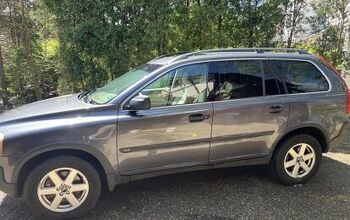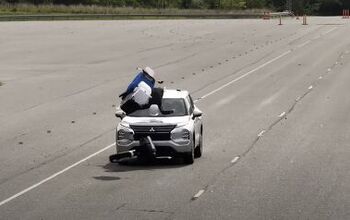Ask Jack: Thirty-four With an "L"?

About 20 years ago, I was working on the technical staff of a small hospital under the theoretical supervision of a nice old woman whose name escapes me. When I say “old” I mean about the same age I am now, by the way. She had a 1991 Buick LeSabre and she was having some sort of problem with it that required a long stay in the indifferent care of our local Buick dealership. Around day eight she lost her patience and called the dealership for a good old-fashioned screaming fit.
At some point in said fit, she yelled, “I EXPECT MORE FROM A BUICK THAN THIS!” Then she turned around and froze me with a furious glare, because I was laughing my proverbial ass off. What kind of idiot expected anything special from a Buick in 1999?
Yet there was a time when the tri-shield badge conveyed some real prestige and excellence. My friend Thomas Klockau just wrote something neat about the Electra 225 that has me itching to buy one of those old boats. And while Buick’s current lineup is a mish-mash of Asian hatchbacks and anonymous sedans, there have been a few decent cars in the lineup from time to time. Which happens to be topic of today’s “Ask Jack.”
Jack, I’m in my thirties, no kids or wife, with an office job and a half-hour commute that makes me really crazy. I want to get something that is cheapish to drive and I don’t have to worry about it. My budget is $10,000 or less. I was thinking about a comfortable Buick sedan. What’s the difference between a Lucerne and a LaCrosse of the same years and should I look at the Super versions? They’re more expensive. Thanks.
Alright, let’s get into the meat of these undistinguished but surprisingly competent Buicks. For now, let’s confine the discussion to the first-generation LaCrosse, sold for model years 2005 through 2009, and the only Lucerne, sold for model years 2006-2011. There was a two-year period where you could buy the second-generation LaCrosse and the Lucerne in showrooms, but even though I have some outrageously fond memories of that second-gen car, I don’t think Michael is really looking at them since he discusses the “Super,” which was limited to the first-gen car.
The LaCrosse is a W-body, kin to the Impala and the Grand Prix. The Lucerne is a G-body, kin to the second-generation Aurora and the Cadillac DTS. About five inches in both wheelbase and overall length separate the cars. Both platforms were basically two decades old by the time they were discontinued. I’m partial to the G over the W because it is extremely stiff and remarkably quiet in most applications. So I’d say the Lucerne is worth the extra money over a LaCrosse — except there isn’t much difference in pricing. CarGurus shows me solid, 60,000-mile Lucernes for well under $10,000 all across the country. You wouldn’t pay much less for a LaCrosse.
In 2009, the Lucerne switched to the so-called “High Value” V6, ditching the almighty 3800. From what I can tell, the reliability of the High Value has been pretty good — but of course the last 3800 variants were pretty much legendary. It’s your choice. I’d feel good about buying a 3.9-liter Lucerne.
The story is a little different when we consider the “Super” variants. The LaCrosse Super was powered by the 5.3-liter LT4 Chevrolet V8, basically the same thing you got in an Impala SS or Grand Prix GTP. It’s a hell of an engine with very few issues and a very low cost of operation. It’s easy to increase the power as well; your primary limitation is the transaxle. I’ve heard of quite a few 12-second LT4-powered cars.
The Lucerne Super, on the other hand, was powered by the 4.6-liter Northstar Cadillac V8. Opinions on the Northstar vary, and there are some aftermarket fixes available now for the engine’s most common issues. Still, I’d be a little wary. My old pal “Sanjeev” Mehta gave it a good review when it was new, however. Just be aware that you’re buying more potential problems that you would be with a V6 Lucerne or a LaCrosse Super.
I think the right move here is to buy the nicest, newest V6 Lucerne you can afford. Get one with 50,000 miles and a little-old-lady ownership history. Then enjoy a decade’s worth of quiet, trouble-free motoring at an extremely low cost. It’s no Electra 225. It’s not even a 1980 Buick Century Sport 5.0 Estate. Compared to the modern Envision, however, it might as well be an S-Class. When all is said and done, I think you’ll be able to expect plenty from your Buick.

More by Jack Baruth
Latest Car Reviews
Read moreLatest Product Reviews
Read moreRecent Comments
- Haran Spot-on review of the Mercedes-AMG GT’s price adjustments and new features! For those intrigued by the all-wheel drive and enhanced features of the latest model, you can delve deeper with the complete operator's manual available here: https://chatwithmanuals.com/automobiles/mercedes-amg-gt-operators-manual-edition-c2020/. It’s a fantastic resource for understanding all the specs and new additions without getting bogged down by the complexity typically associated with car manuals. Chat with the manual using AI to quickly find exactly what you need to know about this sporty beast. Perfect for those who appreciate detailed insights on their luxury investments!
- Flashindapan Beautiful color combinations. I assumed they stop selling the TT here at least five or six years ago.
- Carson D Just don't be the whistleblower who reports on the falsification of safety data. That's a deadly profession.
- Carson D I'd have responded sooner, but my computer locked up and I had to reboot it.
- Todd In Canada Mazda has a 3 year bumper to bumper & 5 year unlimited mileage drivetrain warranty. Mazdas are a DIY dream of high school auto mechanics 101 easy to work on reliable simplicity. IMO the Mazda is way better looking.


































Comments
Join the conversation
3.8. V6. Enough said. I have owned over 15 cars with that motor between my wife and I over the past 25 yrs. By a LeSabre, 2005 Limited, low mile gem. You will love the comfort. I just picked one up to offset my rwd N* STS. The STS eats premium fuel like candy, but loads of power. LeSabre is the incognito Grampy car no one will see or care about. The Lucerne will not be comfortable. Owned one new, 3hrs, the seats were never great al all. New LaCrosse with the 3.8 is nice, but again, comfort will be compromised.
I don't know about the car itself (it was never sold here). As for the engine, the 3800 is just one of those engines that just keeps on running and running. I still see 3800-powered Commodores rather frequently. They are excellent cruisers, and the 4L60E does the job. I would choose the Lucerne with a 3800 if I was in this situation. As for alternatives, as others have mentioned: Toyota Avalon, Toyota Camry, Lexus ES.